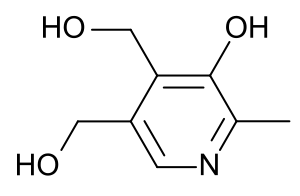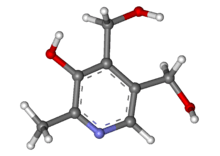Pyridoxine
Pyridoxine, also known as vitamin B6, is a form of vitamin B6 found commonly in food and used as dietary supplement.[1] As a supplement it is used to treat and prevent pyridoxine deficiency, sideroblastic anaemia, pyridoxine-dependent epilepsy, certain metabolic disorders, side effects or complications of isoniazid use, and certain types of mushroom poisoning.[5][1] It is used by mouth or by injection.[5]
 | |
 Pyridoxine | |
| Clinical data | |
|---|---|
| Other names | vitamin B6,[1] pyridoxol[2] pyridoxine hydrochloride |
| AHFS/Drugs.com | Monograph |
| License data |
|
| Pregnancy category | |
| Routes of administration | By mouth, intravenous (IV), intramuscular (IM), subcutaneous |
| ATC code | |
| Legal status | |
| Legal status | |
| Identifiers | |
| |
| CAS Number | |
| DrugBank | |
| ChemSpider | |
| UNII | |
| KEGG | |
| ChEBI | |
| ChEMBL | |
| CompTox Dashboard (EPA) | |
| ECHA InfoCard | 100.000.548 |
| Chemical and physical data | |
| Formula | C8H11NO3 |
| Molar mass | 169.180 g·mol−1 |
| 3D model (JSmol) | |
| Melting point | 159 to 162 °C (318 to 324 °F) |
| |
| |
It is usually well tolerated.[5] Occasionally side effects include headache, numbness, and sleepiness.[5] Normal doses are safe during pregnancy and breastfeeding.[5] Pyridoxine is in the vitamin B family of vitamins.[5] It is required by the body to make amino acids, carbohydrates, and lipids.[5] Sources in the diet include fruit, vegetables, and grain.[6]
Pyridoxine was discovered in 1934, isolated in 1938, and first made in 1939.[7][8] It is on the World Health Organization's List of Essential Medicines, the safest and most effective medicines needed in a health system.[9] Pyridoxine is available both as a generic medication and over the counter product.[5] The wholesale cost in the developing world is about US$0.59–3.54 per month.[10] Foods, such as breakfast cereal have pyridoxine added in some countries.[6]
Medical uses
As a supplement it is used to treat and prevent pyridoxine deficiency, sideroblastic anaemia, pyridoxine-dependent epilepsy, certain metabolic disorders, problems from isoniazid, and certain types of mushroom poisoning.[5][1] Pyridoxine-dependent epilepsy is a type of rare epilepsy that does not improve with typical antiseizure medications.[11] Pyridoxine is used by mouth or by injection.[5]
Pyridoxine in combination with doxylamine is used as a treatment for morning sickness in pregnant women. It has been used in hydrazine exposure with unclear effect.[12]
Side effects
It is usually well tolerated, though overdose toxicity is possible.[5] Occasionally side effects include headache, numbness, and sleepiness.[5] Pyridoxine overdose can cause a peripheral sensory neuropathy characterized by poor coordination, numbness, and decreased sensation to touch, temperature, and vibration (https://www.medlink.com/article/pyridoxine_deficiency_and_toxicity). Healthy human blood levels of pyridoxine are 2.1 - 21.7 ng/mL. Normal doses are safe during pregnancy and breastfeeding.[5]
Mechanism
Pyridoxine is in the vitamin B family of vitamins.[5] It is required by the body to make amino acids, carbohydrates, and lipids.[5] Sources in the diet include fruit, vegetables, and grain.[6] It is also required for muscle phosphorylase activity associated with glycogen metabolism.
History and culture
Pyridoxine was discovered in 1934, isolated in 1938, and first made in 1939.[7][8] It is on the World Health Organization's List of Essential Medicines, the most effective and safe medicines needed in a health system.[9] Pyridoxine is available as a generic medication and over the counter.[5] The wholesale cost in the developing world is about US$0.59–3.54 per month.[10] Foods, such as breakfast cereal have pyridoxine added in some countries.[6]
References
- World Health Organization (2009). Stuart MC, Kouimtzi M, Hill SR (eds.). WHO Model Formulary 2008. World Health Organization. p. 496. hdl:10665/44053. ISBN 9789241547659.
- Dryhurst, Glenn (2012). Electrochemistry of Biological Molecules. Elsevier. p. 562. ISBN 9780323144520. Archived from the original on 30 December 2016.
- "Pyridoxine Use During Pregnancy". Drugs.com. 27 April 2020. Retrieved 6 May 2020.
- "Pyridoxine 50mg Tablets - Summary of Product Characteristics (SmPC)". (emc). 27 April 2015. Retrieved 6 May 2020.
- "Pyridoxine Hydrochloride". The American Society of Health-System Pharmacists. Archived from the original on 30 December 2016. Retrieved 8 December 2016.
- "Office of Dietary Supplements - Dietary Supplement Fact Sheet: Vitamin B6". ods.od.nih.gov. 11 February 2016. Archived from the original on 12 December 2016. Retrieved 30 December 2016.
- Squires, Victor R. (2011). The Role of Food, Agriculture, Forestry and Fisheries in Human Nutrition - Volume IV. EOLSS Publications. p. 121. ISBN 9781848261952.
- Harris, Harry (2012). Advances in Human Genetics 6. Springer Science & Business Media. p. 39. ISBN 9781461582649.
- World Health Organization (2019). World Health Organization model list of essential medicines: 21st list 2019. Geneva: World Health Organization. hdl:10665/325771. WHO/MVP/EMP/IAU/2019.06. License: CC BY-NC-SA 3.0 IGO.
- "Vitamin B6". International Drug Price Indicator Guide. Retrieved 8 December 2016.
- Abend, NS; Loddenkemper, T (July 2014). "Management of pediatric status epilepticus". Current Treatment Options in Neurology. 16 (7): 301. doi:10.1007/s11940-014-0301-x. PMC 4110742. PMID 24909106.
- "Hydrazine (EHC 68, 1987)". www.inchem.org. Retrieved 20 November 2018.
External links

- Pyridoxine mass spectrum
- "Pyridoxine". Drug Information Portal. U.S. National Library of Medicine.